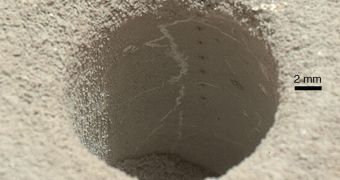Scientists operating the Mars Science Laboratory (MSL) rover Curiosity announce the discovery of an ancient lake that existed on the surface of the Red Planet around 3.7 billion years ago. Analysis of the rocks at this location suggests that this body of water may have been capable of supporting life.
According to a new study, details of which appear in the December 9 issue of the top journal Science, the lake remained able to host microbial life for several millions of years after it first formed. This conclusion seems to indicate that Mars may have been habitable a lot more recently than first thought.
For this research, experts had Curiosity study a series of sedimentary rock outcrops, located at a site called Yellowknife Bay, inside Gale Crater. These mudstones provide the first piece of conclusive evidence that at least one lake existed inside this impact basin since the planet formed.
The rover's advanced instruments demonstrated the presence of critically important elements, including carbon, hydrogen, oxygen, nitrogen and sulfur, in the waters of the ancient lake. Very simple microbial lifeforms would have thrived at this location, MSL scientists say.
“Quite honestly, it just looks very Earth-like,” comments John Grotzinger, the lead scientist for Curiosity at the California Institute of Technology (Caltech), in Pasadena. Potential organisms in this lake would have resembled chemolithoautotrophs living in caves and near hydrothermal vents on Earth.
The expert adds that the former lake may have occupied an area 50 kilometers long by 5 kilometers wide (30 miles by 3 miles). Gale Crater has a diameter of 154 kilometers (96 miles).
“It is important to note that we have not found signs of ancient life on Mars. What we have found is that Gale Crater was able to sustain a lake on its surface at least once in its ancient past that may have been favorable for microbial life, billions of years ago,” says researcher Sanjeev Gupta.
“This is a huge positive step for the exploration of Mars” adds the expert, who holds an appointment with the Department of Earth Science and Engineering at the Imperial College London (ICL). He is also a member of the MSL science team, and a coauthor of the new paper.
Gupta says that chemolithoautotrophs live by breaking down rocks and several minerals. This allows them to convert a rich array of elements into energy. Future studies will potentially help MSL scientists figure out whether or not the Red Planet actually supported life in the distant past.

 14 DAY TRIAL //
14 DAY TRIAL //